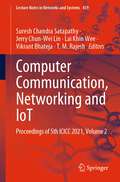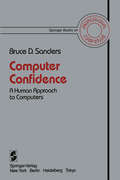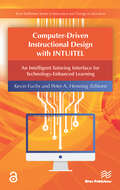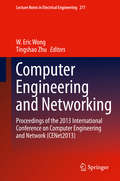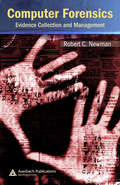- Table View
- List View
Computer Communication, Networking and IoT: Proceedings of 5th ICICC 2021, Volume 2 (Lecture Notes in Networks and Systems #459)
by Suresh Chandra Satapathy Jerry Chun-Wei Lin Lai Khin Wee Vikrant Bhateja T. M. RajeshThis book features a collection of high-quality, peer-reviewed papers presented at the Fifth International Conference on Intelligent Computing and Communication (ICICC 2021) organized by the Department of Computer Science and Engineering and Department of Computer Science and Technology, Dayananda Sagar University, Bengaluru, India, on November 26 – 27, 2021. The book is organized in two volumes and discusses advanced and multi-disciplinary research regarding the design of smart computing and informatics. It focuses on innovation paradigms in system knowledge, intelligence, and sustainability that can be applied to provide practical solutions to a number of problems in society, the environment and industry. Further, the book also addresses the deployment of emerging computational and knowledge transfer approaches, optimizing solutions in various disciplines of science, technology, and healthcare.
Computer Communications
by R. COLEThe subject of computer communications is changing very rapidly. Improvements in terminal access, aligned with the development of timesharing, has brought hands-on experience to a large number of non specialist users. Computer networks have made available vast computing resources and data banks to these users. This book is for anyone familiar with using computers who wishes to understand the techniques used in computer communications. It is also an introduction to the architecture of present day computer communication systems. I would like to thank Roland lbbett, Steve Treadwell, Peter Kirstein and Del Thomas for their invaluable advice and encouragement. My thanks also to Malcolm Stewart and the staff at Macmillan. The late Gareth Pugh encouraged my interest in computer communications and provided the opportunity to develop the material for this book. The text was formatted on a UNIX computer system: I am grateful to Professor Kirstein for permission to use this system. I am indebted to NEC Telecommunications Europe for the use of a spinwriter printer on which the master copy was produced. Finally, no amount of words can express my debt to Jo this project and Rosemary for patiently bearing with over the last three years.
Computer Communications and Networks (Applications of Communications Theory)
by John R. FreerComputer communications is one of the most rapidly developing technologies and it is a subject with which everyone in the computer systems profession should be familiar. Computer communications and networks is an introduction to communications technology and system design for practising and aspiring computer professionals. The subject is described from the computer system designer's point of view rather than from the communications engineer's viewpoint. The presentation is suitable for introductory reading as well as for reference. The emphasis is on practical, rather than theoretical, aspects and on technology which will become more important in the future. The majority of the subject matter applies to civil and military communications but some aspects which are unique to military applications have been included where considered signifi cant. Computer communications is a rapidly changing and highly complex subject. Sufficient practical knowledge of the subject is not usually gained at university or college but is generally developed over a period of several years by trial and error, attending courses, reading reference books and journals; this book attempts to simplify and speed up the process by bringing together a body of information which is otherwise distributed throughout many books and journals. The information is presented in a framework which makes a wider understanding of the subject possible. Basic knowledge of communications is assumed, a general famil iarity with computer systems is anticipated in later chapters, and, where relevant, theory is explained.
Computer Confidence: A Human Approach to Computers (Springer Books on Professional Computing)
by Bruce D. SandersMuch of the material in this book comes from what I've learned as I've traveled around the country conducting seminars about working profitably in the automated office. During the first few months of those seminars, there was a question I was asked more often than any other single question. I wa~ asked the question so often that I gave it a nickname. I called it my "What The Devil" question. Often in different words, usually at the morning break in the seminar, and almost always with an effort not to offend or embarrass, I was asked, "What the devil is a psychologist doing conducting seminars about computer systems?" I'm not asked "What the Devil" questions much anymore. Those familiar with office automation have come to realize that human factors chiefly determine whether a computer system will be a success or an expensive failure. So many computer systems have not gained acceptance by is employees because the planners didn't use good psychological sense. That especially true as the computers move from the Engineering Department into the executive suites and the role of computers changes from just producing paper into also assisting in managerial decision making. One human factor I've learned is that people would much rather skip around in a book than read it from front cover to back cover directly. It's true whether the book is a user manual for office equipment or a volume on computer systems for decision makers.
Computer-Driven Instructional Design with INTUITEL: An Intelligent Tutoring Interface For Technology-enhanced Learning (River Publishers Series In Innovation And Change In Education Ser.)
by Kevin Fuchs Peter A. HenningINTUITEL is a research project that was co-financed by the European Commission with the aim to advance state-of-the-art e-learning systems via addition of guidance and feedback for learners. Through a combination of pedagogical knowledge, measured learning progress and a broad range of environmental and background data, INTUITEL systems will provide guidance towards an optimal learning pathway. This allows INTUITEL-enabled learning management systems to offer learners automated, personalised learning support so far only provided by human tutors INTUITEL is - in the first place - a design pattern for the creation of adaptive e-learning systems. It focuses on the reusability of existing learning material and especially the annotation with semantic meta data. INTUITEL introduces a novel approach that describes learning material as well as didactic and pedagogical meta knowledge by the use of ontologies. Learning recommendations are inferred from these ontologies during runtime. This way INTUITEL solves a common problem in the field of adaptive systems: it is not restricted to a certain field. Any content from any domain can be annotated. The INTUITEL research team also developed a prototype system. Both the theoretical foundations and how to implement your own INTUITEL system are discussed in this book.
Computer-Driven Instructional Design with INTUITEL
INTUITEL is a research project that was co-financed by the European Commission with the aim to advance state-of-the-art e-learning systems via addition of guidance and feedback for learners. Through a combination of pedagogical knowledge, measured learning progress and a broad range of environmental and background data, INTUITEL systems will provide guidance towards an optimal learning pathway. This allows INTUITEL-enabled learning management systems to offer learners automated, personalised learning support so far only provided by human tutors INTUITEL is - in the first place - a design pattern for the creation of adaptive e-learning systems. It focuses on the reusability of existing learning material and especially the annotation with semantic meta data. INTUITEL introduces a novel approach that describes learning material as well as didactic and pedagogical meta knowledge by the use of ontologies. Learning recommendations are inferred from these ontologies during runtime. This way INTUITEL solves a common problem in the field of adaptive systems: it is not restricted to a certain field. Any content from any domain can be annotated. The INTUITEL research team also developed a prototype system. Both the theoretical foundations and how to implement your own INTUITEL system are discussed in this book.
Computer Electronics: Made Simple Computerbooks
by J. F. B. BourdillonComputer Electronics: Made Simple Computerbooks presents the basics of computer electronics and explains how a microprocessor works. Various types of PROMs, static RAMs, dynamic RAMs, floppy disks, and hard disks are considered, along with microprocessor support devices made by Intel, Motorola and Zilog. Bit slice logic and some AMD bit slice products are also described. Comprised of 14 chapters, this book begins with an introduction to the fundamentals of hardware design, followed by a discussion on the basic building blocks of hardware (NAND, NOR, AND, OR, NOT, XOR); tools and equipment that are required by a hardware engineer; and sequential logic. Subsequent chapters focus on analog components such as transistors, resistors, capacitors, diodes, crystals, and power supplies; data sheets and data books; timing diagrams; arithmetic using integrated circuits, with emphasis on full adders, arithmetic logic units, and arithmetic processing units. The final chapter describes how a project operates, how the computer-aided design process works, and how printed circuit boards are manufactured. This monograph will be of interest to students, engineers, and other practitioners in computer electronics.
Computer Engineering and Networking: Proceedings of the 2013 International Conference on Computer Engineering and Network (CENet2013) (Lecture Notes in Electrical Engineering #10152)
by W. Eric Wong Tingshao ZhuThis book aims to examine innovation in the fields of computer engineering and networking. The book covers important emerging topics in computer engineering and networking, and it will help researchers and engineers improve their knowledge of state-of-art in related areas. The book presents papers from The Proceedings of the 2013 International Conference on Computer Engineering and Network (CENet2013) which was held on 20-21 July, in Shanghai, China.
Computer Engineering and Technology: 19th CCF Conference, NCCET 2015, Hefei, China, October 18-20, 2015, Revised Selected Papers (Communications in Computer and Information Science #592)
by Weixia Xu Liquan Xiao Jinwen Li Chengyi ZhangThis book constitutes the refereed proceedings of the 19th CCF Conference on Computer Engineering and Technology, NCCET 2015, held in Hefei, China, in October 2015. The 18 papers presented were carefully reviewed and selected from 158 submissions. They are organized in topical sections on processor architecture; application specific processors; computer application and software optimization; technology on the horizon.
Computer Engineering and Technology: 18th CCF Conference, NCCET 2014, Guiyang, China, July 29 -- August 1, 2014. Revised Selected Papers (Communications in Computer and Information Science #491)
by Weixia Xu Liquan Xiao Jinwen Li Chengyi Zhang Zhenzhen ZhuThis book constitutes the refereed proceedings of the 18th National Conference on Computer Engineering and Technology, NCCET 2014, held in Guiyang, China, during July/August 2014. The 18 papers presented were carefully reviewed and selected from 85 submissions. They are organized in topical sections on processor architecture; computer application and software optimization; technology on the horizon.
Computer Engineering and Technology: 20th CCF Conference, NCCET 2016, Xi'an, China, August 10-12, 2016, Revised Selected Papers (Communications in Computer and Information Science #666)
by Weixia Xu Liquan Xiao Jinwen Li Chengyi Zhang Zhenzhen ZhuThis book constitutes the refereed proceedings of the 20th CCF Conference on Computer Engineering and Technology, NCCET 2016, held in Xi'an, China, in August 2016. The 21 full papers presented were carefully reviewed and selected from 120 submissions. They are organized in topical sections on processor architecture; application specific processors; computer application and software optimization; technology on the horizon.
Computer Engineering and Technology: 21st CCF Conference, NCCET 2017, Xiamen, China, August 16–18, 2017, Revised Selected Papers (Communications in Computer and Information Science #600)
by Weixia Xu Liquan Xiao Jinwen Li Chengyi Zhang Zhenzhen ZhuThis book constitutes the refereed proceedings of the 21th CCF Conference on Computer Engineering and Technology, NCCET 2017, held in Xiamen, China, in August 2017. The 13 full papers presented were carefully reviewed and selected from 108 submissions. They address topics such as processor architecture; application specific processors; computer application and software optimization; technology on the horizon.
Computer Engineering and Technology: 22nd CCF Conference, NCCET 2018, Yinchuan, China, August 15–17, 2018, Revised Selected Papers (Communications in Computer and Information Science #994)
by Weixia Xu Liquan Xiao Jinwen Li Zhenzhen ZhuThis book constitutes the refereed proceedings of the 22nd CCF Conference on Computer Engineering and Technology, NCCET 2018, held in Yinchuan, China, in August 2018.The 17 full papers presented were carefully reviewed and selected from 120 submissions. They address topics such as processor architecture; application specific processors; computer application and software optimization; technology on the horizon.
Computer Engineering and Technology: 23rd CCF Conference, NCCET 2019, Enshi, China, August 1–2, 2019, Revised Selected Papers (Communications in Computer and Information Science #1146)
by Weixia Xu Liquan Xiao Jinwen Li Zhenzhen ZhuThis book constitutes the refereed proceedings of the 23rd CCF Conference on Computer Engineering and Technology, NCCET 2019, held in Enshi, China, in August 2019. The 21 full papers presented were carefully reviewed and selected from 87 submissions. They address important and emerging challenges in the field of computer engineering and technology.
Computer Engineering and Technology: 16th National Conference, NCCET 2012, Shanghai, China, August 17-19, 2012, Revised Selected Papers (Communications in Computer and Information Science #337)
by Weixia Xu Liquan Xiao Pingjing Lu Jinwen Li Chengyi ZhangThis book constitutes the refereed proceedings of the 16th National Conference on Computer Engineering and Technology, NCCET 2012, held in Shanghai, China, in August 2012. The 27 papers presented were carefully reviewed and selected from 108 submissions. They are organized in topical sections named: microprocessor and implementation; design of integration circuit; I/O interconnect; and measurement, verification, and others.
Computer Engineering and Technology: 17th National Conference, NCCET 2013, Xining, China, July 20-22, 2013. Revised Selected Papers (Communications in Computer and Information Science #396)
by Weixia Xu Liquan Xiao Chengyi Zhang Jinwen Li Liyan YuThis book constitutes the refereed proceedings of the 17th National Conference on Computer Engineering and Technology, NCCET 2013, held in Xining, China, in July 2013. The 26 papers presented were carefully reviewed and selected from 234 submissions. They are organized in topical sections named: Application Specific Processors; Communication Architecture; Computer Application and Software Optimization; IC Design and Test; Processor Architecture; Technology on the Horizon.
Computer Facial Animation
by Frederic I. Parke Keith WatersThis comprehensive work provides the fundamentals of computer facial animation and brings into sharper focus techniques that are becoming mainstream in the industry. Over the past decade, since the publication of the first edition, there have been significant developments by academic research groups and in the film and games industries leading to t
Computer Flowchart (large print)
by RnibThis flowchart diagram shows, in a typical system, what peripheral components are attached to a computer and how data, represented by arrows, moves between them and the computer. Each element in the diagram is shown as a rectangle. There is a locator dot shown, which will be at the top left of the page when the image is the right way up. In the centre of the page is the computer (processor) shown in a striped texture. To the left of this is a keyboard and mouse with arrows pointing right from them to the computer. To the right is a CD-ROM with an arrow pointing to the computer, and a disc drive with arrows pointing to and from the computer. There are arrows pointing from the computer up the page to the screen and down the page to a printer.
Computer Flowchart (UEB contracted)
by RnibThis flowchart diagram shows, in a typical system, what peripheral components are attached to a computer and how data, represented by arrows, moves between them and the computer. Each element in the diagram is shown as a rectangle. There is a locator dot shown, which will be at the top left of the page when the image is the right way up. In the centre of the page is the computer (processor) shown in a striped texture. To the left of this is a keyboard and mouse with arrows pointing right from them to the computer. To the right is a CD-ROM with an arrow pointing to the computer, and a disc drive with arrows pointing to and from the computer. There are arrows pointing from the computer up the page to the screen and down the page to a printer.
Computer Flowchart (UEB uncontracted)
by RnibThis flowchart diagram shows, in a typical system, what peripheral components are attached to a computer and how data, represented by arrows, moves between them and the computer. Each element in the diagram is shown as a rectangle. There is a locator dot shown, which will be at the top left of the page when the image is the right way up. In the centre of the page is the computer (processor) shown in a striped texture. To the left of this is a keyboard and mouse with arrows pointing right from them to the computer. To the right is a CD-ROM with an arrow pointing to the computer, and a disc drive with arrows pointing to and from the computer. There are arrows pointing from the computer up the page to the screen and down the page to a printer.
Computer Forensics: Evidence Collection and Management
by Robert C. NewmanComputer Forensics: Evidence Collection and Management examines cyber-crime, E-commerce, and Internet activities that could be used to exploit the Internet, computers, and electronic devices. The book focuses on the numerous vulnerabilities and threats that are inherent on the Internet and networking environments and presents techniques and
Computer Forensics For Dummies
by Carol Pollard Reynaldo AnzalduaUncover a digital trail of e-evidence by using the helpful, easy-to-understand information in Computer Forensics For Dummies! Professional and armchair investigators alike can learn the basics of computer forensics, from digging out electronic evidence to solving the case. You won’t need a computer science degree to master e-discovery. Find and filter data in mobile devices, e-mail, and other Web-based technologies. You’ll learn all about e-mail and Web-based forensics, mobile forensics, passwords and encryption, and other e-evidence found through VoIP, voicemail, legacy mainframes, and databases. You’ll discover how to use the latest forensic software, tools, and equipment to find the answers that you’re looking for in record time. When you understand how data is stored, encrypted, and recovered, you’ll be able to protect your personal privacy as well. By the time you finish reading this book, you’ll know how to: Prepare for and conduct computer forensics investigations Find and filter data Protect personal privacy Transfer evidence without contaminating it Anticipate legal loopholes and opponents’ methods Handle passwords and encrypted data Work with the courts and win the case Plus, Computer Forensics for Dummies includes lists of things that everyone interested in computer forensics should know, do, and build. Discover how to get qualified for a career in computer forensics, what to do to be a great investigator and expert witness, and how to build a forensics lab or toolkit. Note: CD-ROM/DVD and other supplementary materials are not included as part of eBook file.
Computer Forensics For Dummies
by Carol Pollard Reynaldo AnzalduaUncover a digital trail of e-evidence by using the helpful, easy-to-understand information in Computer Forensics For Dummies! Professional and armchair investigators alike can learn the basics of computer forensics, from digging out electronic evidence to solving the case. You won’t need a computer science degree to master e-discovery. Find and filter data in mobile devices, e-mail, and other Web-based technologies. You’ll learn all about e-mail and Web-based forensics, mobile forensics, passwords and encryption, and other e-evidence found through VoIP, voicemail, legacy mainframes, and databases. You’ll discover how to use the latest forensic software, tools, and equipment to find the answers that you’re looking for in record time. When you understand how data is stored, encrypted, and recovered, you’ll be able to protect your personal privacy as well. By the time you finish reading this book, you’ll know how to: Prepare for and conduct computer forensics investigations Find and filter data Protect personal privacy Transfer evidence without contaminating it Anticipate legal loopholes and opponents’ methods Handle passwords and encrypted data Work with the courts and win the case Plus, Computer Forensics for Dummies includes lists of things that everyone interested in computer forensics should know, do, and build. Discover how to get qualified for a career in computer forensics, what to do to be a great investigator and expert witness, and how to build a forensics lab or toolkit. Note: CD-ROM/DVD and other supplementary materials are not included as part of eBook file.
Computer Forensics JumpStart: Computer Forensics Basics
by Michael G. Solomon K. Rudolph Ed Tittel Neil Broom Diane BarrettEssential reading for launching a career in computer forensics Internet crime is on the rise, catapulting the need for computer forensics specialists. This new edition presents you with a completely updated overview of the basic skills that are required as a computer forensics professional. The author team of technology security veterans introduces the latest software and tools that exist and they review the available certifications in this growing segment of IT that can help take your career to a new level. A variety of real-world practices take you behind the scenes to look at the root causes of security attacks and provides you with a unique perspective as you launch a career in this fast-growing field. Explores the profession of computer forensics, which is more in demand than ever due to the rise of Internet crime Details the ways to conduct a computer forensics investigation Highlights tips and techniques for finding hidden data, capturing images, documenting your case, and presenting evidence in court as an expert witness Walks you through identifying, collecting, and preserving computer evidence Explains how to understand encryption and examine encryption files Computer Forensics JumpStart is the resource you need to launch a career in computer forensics.
